Renovating guide from NZ Property Investor magazine
Adam Wareing drew on the help of his parents to purchase his first investment property, and it's been a renovation success story.
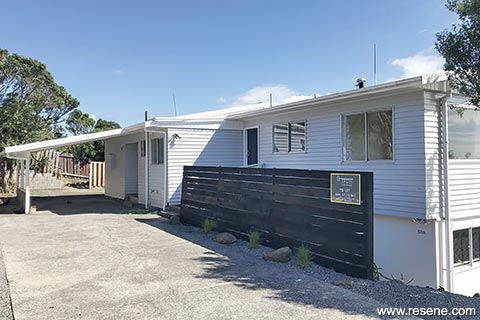
Wareing entered a joint venture with his parents to secure a double-income dwelling.
He may only be 22, but Adam Wareing from Wellington has already proven he's got the right stuff when it comes to renovations. Software developer by day, the young investor spent the evenings and weekends of the first part of the year working on the renovation of a home and income in Newlands.
He was thrown in the deep end, with a renovation that was full of thorny challenges. But he's come out the other side with knowledge and a fire in his belly: property investment is now firmly part of his master plan.
Wareing had been looking for an investment property in Wellington for a while, but the market's vertiginous ascent made it difficult. So when he found out that his parents were looking to invest some of the money they had saved into a property, he decided it was the perfect way to get ahead.
“I realised that if I owned half of a slightly more expensive property it would actually work out better for me than if I owned a cheap, grubby place in the outer suburbs,” he says.
The property they discovered was located in the central suburb of Newlands. Built in the early 1970s, with weatherboard cladding and a large section, the four bedroom home with single bedroom unit downstairs had a huge amount of investment potential.

Rather than bothering with the consents that would have been needed to remove a wall, Wareing decided to get the builders to cut a U-shaped space in the wall. This is used as a breakfast bar and opens up the room.
But it needed work. The upstairs smelled extremely strongly of curry, there were holes in the walls, the bathroom was old and dated and the kitchen was “absolutely revolting”. Downstairs featured awful carpet, and a window that nearly fell out the first time he opened it.
This could account for the reasonable price he paid for it: “It was in the mid-to-late $600s, which was extremely good for Wellington”.
The house was purchased in November last year, with the tenants set to move out in February. But not all went to plan here: “On the day the tenants upstairs were meant to move out they called me to ask if they could stay an extra month, as the place that they had meant to move into was full of mould. They needed time to find something else. As they had a young child, I didn't feel that I could say no.”
This act of kindness put the plans for the upstairs back a month. Nevertheless, once Wareing had access to the place, it was full steam ahead.
As he worked full-time and wasn't a qualified builder, Wareing employed the services of experts to do much of the renovation.
One of the tasks he did himself was to clean up the outside of the house, which was overgrown with toitoi. In fact it was so bad, it took a full weekend and innumerable trips to the dump to clear away what he estimates to be tonnes of the stuff.
“It was growing over a part of the drive and once we cleared it away we discovered about six or seven metres of driveway and parking space that we didn't know was there.”
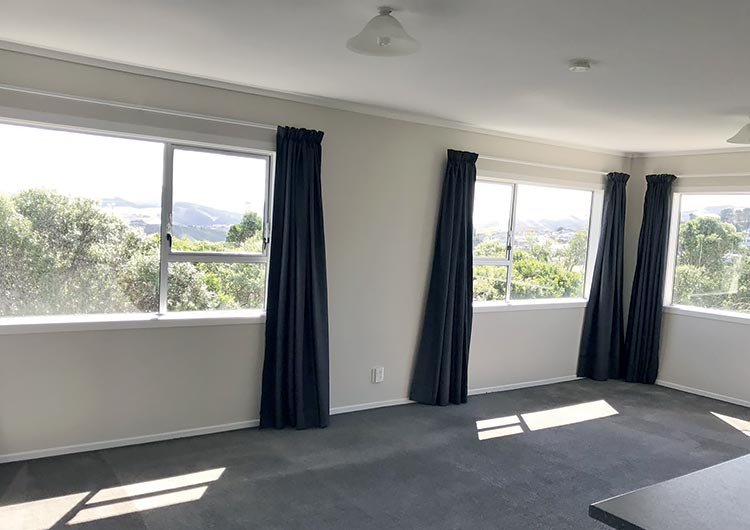
The upstairs lounge smelled strongly and needed a complete re-paint, new carpet and curtains.
Inside, all the walls upstairs needed to be repainted and new carpet and vinyl laid. The smell of curry was so strong upstairs that even after the walls were skimmed, primed and sanded the smell stuck around.
“It was a very pungent smell and took a long time to fade,” he remembers.
The bathroom upstairs was in a sorry state, with an ugly stainless steel shower, and an old mouldy shower curtain that didn't reach all the way down. This had led to some rotting in the floor that needed to be tended to. There was also a tiny vanity that was in no way suitable for a house of that size.
A curved glass shower, new toilet and vanity were installed (he got these from local firm Zip Plumbing). All up the new bathroom only set him back just over $3,000.
The kitchen was another problem area. The ubiquitous 1970s stainless steel was in evidence here as well – the benchtop was made of the stuff, as were the “revolting kitchen taps”. Then there was the rangehood, that looked as though it was about to fall off the wall, plus water had been leaking under the bench and it was rotting through.
It was also extremely poky, as it was closed off from the rest of the house. Rather than bothering with the consents that would have been needed to remove a wall, Wareing decided to get the builders to cut a U-shaped space in the wall. This is used as a breakfast bar and opens up the room to the living space beside it.
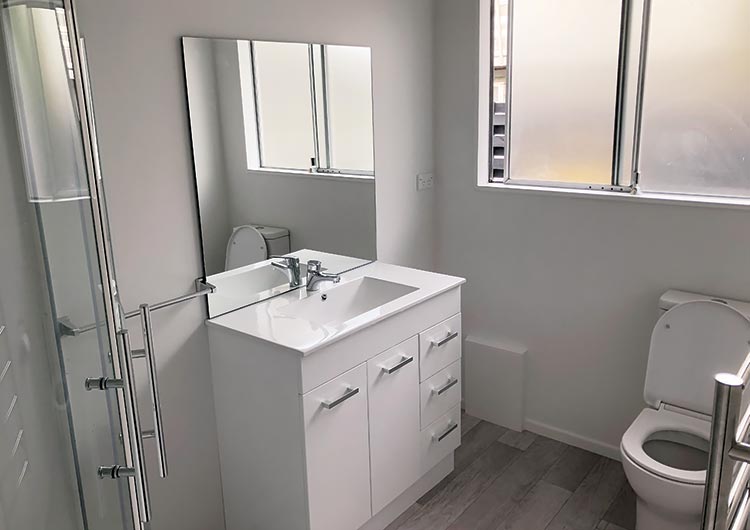
The bathroom renovation cost $3,000 for a new toilet, vanity and shower.
Downstairs, carpet was replaced and the walls, which he hoped would just need tidying up, ended up being completely repainted, and the curtains replaced.
After a solid two months' work, Wareing was able to present the renovated home to the market. Due to the delay around the upstairs tenants not moving out, they missed out on the peak of the rental market. But the improvements still ended up adding an extra $350 worth of rent.
“We now rent the upstairs house for $650 a week (it was rented for $450) and the downstairs unit for $420 a week (it had been $270),” he says.
The house has been revalued at between $850,000 and $900,000, but he feels that it's more likely to be around the $820,000 mark. The renovation ended up costing in the region of $75,000 – even though the budget was $45,000 he's not concerned.
“We just increased the scope of the renovation, and the Healthy Homes Bill changes were coming into place, so we did things like putting a heat pump in the downstairs unit.”
With the gains made in value, Wareing plans to purchase his own home, and then look for more homes on which he can work his renovation magic.
| Purchase price: | Mid-$600s |
| Cost of renovation: | $75,000 |
| Value after renovation: | $820,000 |
| Rental per week before renovation: | $720 |
| Rental per week after renovation: | $1070 for both dwellings |
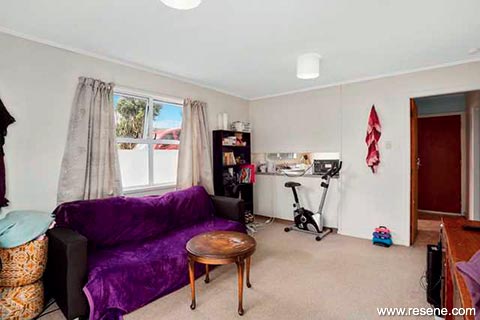
Kitchen (before)

Lounge (before)

Bathroom (before)
Double dwellings can provide investors with far more bang for their bucks, but it pays to be strategic about how much you spend on renovations. In Wareing's case, the kitchen and bathroom in the secondary dwelling weren't great, but they would do in the meantime, so he decided to leave them as is.
When looking at renovating a second dwelling alongside a larger home on the same property, try to use the same paints, carpets, curtains and vinyl. You will be able to get better deals if you buy in bulk and leftover paint may well be enough to spruce up an entire smaller dwelling.
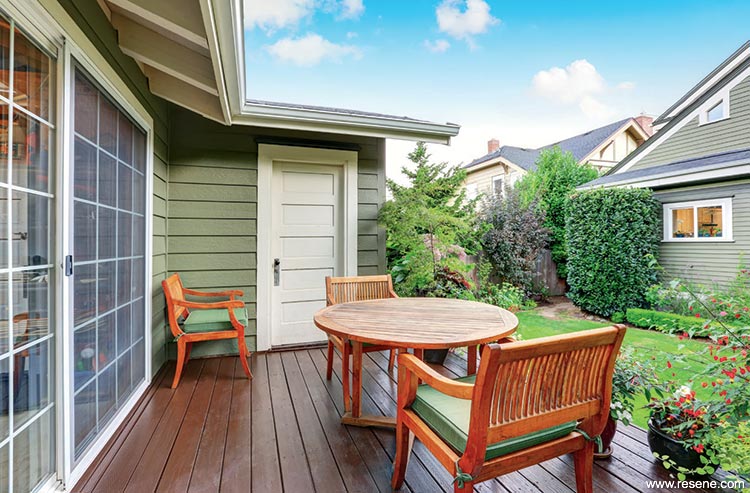
Make sure you do your homework when it comes to any structural work in smaller dwellings. If you are repositioning such things as baths, showers, or toilets, but not increasing the number of fittings, you probably won't need consent. But if you are adding an extra fitting or installing a tiled shower, you will need to gain consent.
With any outside improvements, make sure the two properties are complementary. Again, using the same paint will save you money but ensure the two dwellings look similar. Just be sensible and do your homework.
With a little bit of hard work, even the least prepossessing second dwellings can return a decent yield. In Wareing's case, a small amount of renovation work took the weekly rent from a measly $270 to $420.
By Joanna Mathers
August 2019
Renovating guide
Learn the tips and tricks for renovating rental properties with this handy information series from NZ Property Investor magazine.